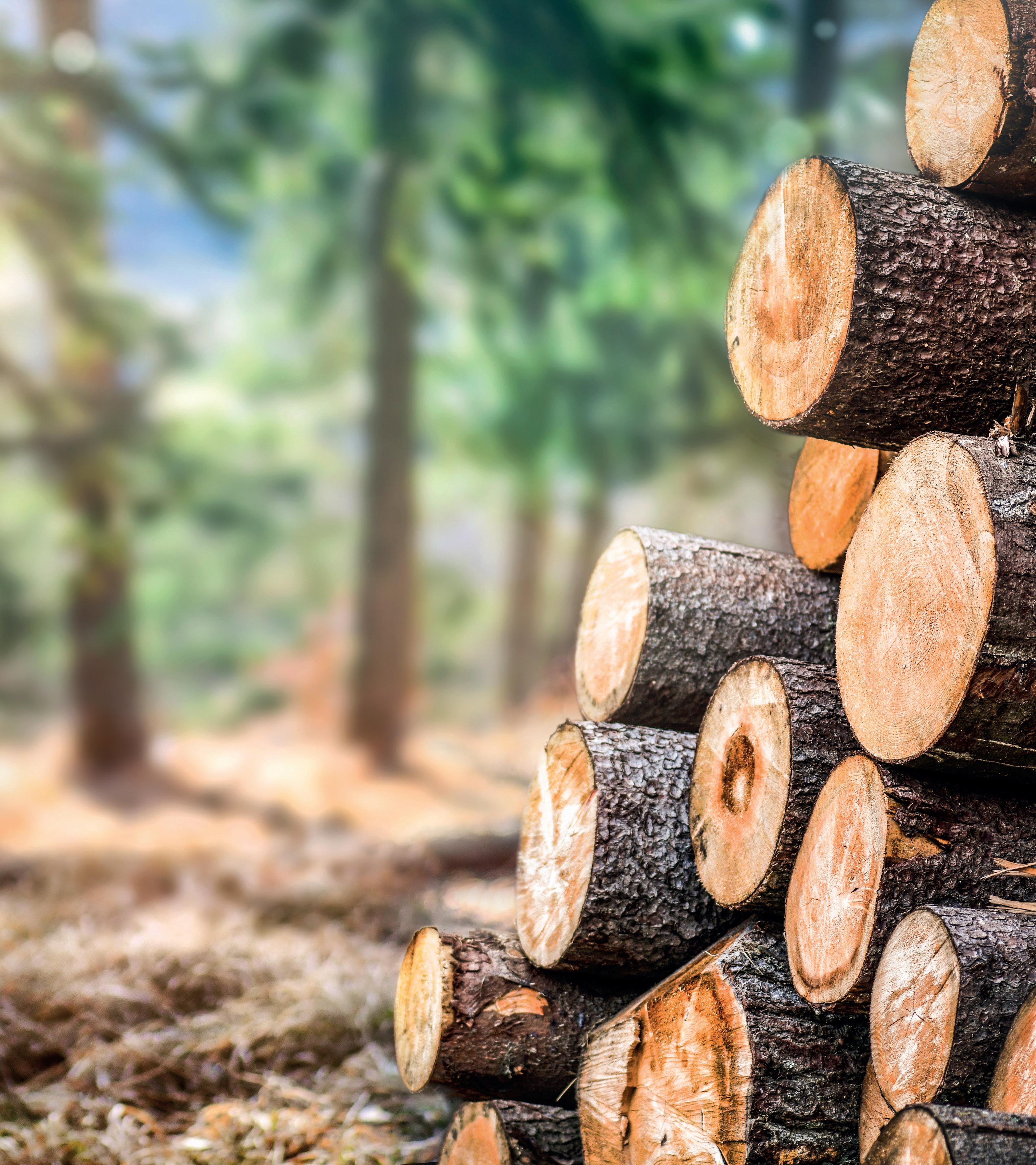

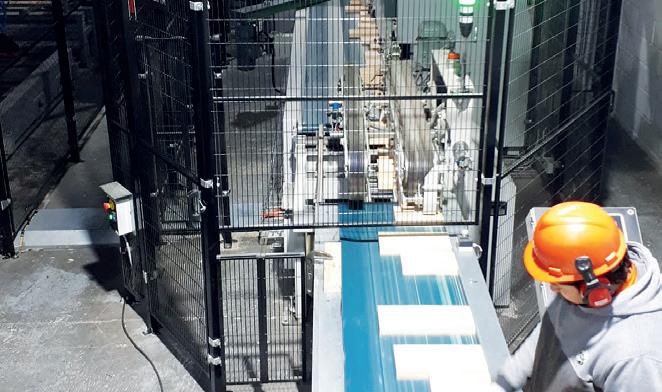



no. 2 - 2022 www.systemtm.com NEWS
of the HOMAG Group optimization of staff and wood resources How System TM Unlocked the Full Potential of Denmark’s Leading Manufacturer of Profiled Products Like any other System TM project, the goal of this one was to boost the manufacturing processes of Denmark's leading manufacturer of profiled products for the con struction industry. Readthefullstoryonpage2-3 Setra Group Maximizes Machine Utilization Through Flexible, Automated Solution Setra, one of Sweden's largest wood product companies, can now produce two different product types using the same production line. Readthefullstoryonpage7 Sägewerk Poschenrieder Adds Functionality and Subtracts Floor Space Enrique R. Zeni y Cía S.A. Achieves Quick Return on Investment by Automating Manual Processes Maximum output and minimum labor needs are two key reasons behind Zeni’s decision to invest in a System TM finger-jointing line. Readthefullstoryonpage6 Read the full story on4-5page
Member
Statement by Allan Them, Area Sales Manager for System TM:
‘‘Theyexpecttheir furtherexpansion tobefacilitatedby this newSystem TM line, and we feel veryprivilegedtobe partoftheirjourney. Withthistop-notch productionline, they’rereadytomeet thecapacityneedsof the future.’’
This System TM solution consists of the following:
• An automated feeding system, Opti-Feed 6000 Vack
• A moulder
• A MiCROTEC Goldeneye 501 scanner
• Two optimizing cross-cut saws, Opti-Kap 5103
• A vertical finger-jointing system, Opti-Joint V-8
• Press unit
• A multiple head cross-cut saw
• An automated stacking system, Opti-Stack 9000


How System TM Unlocked the Full Leading Manufacturer of Profiled
Like any other System TM project, the goal of this one was to boost the manufacturing construction industry. And like any other System TM project, the customer was provided needs. By customizing and automating production processes, System TM has unlocked
Denmark's leading manufacturer of profiled products
While the company mentioned in this article prefers to remain anonymous, its presence on the market is very much known, as it is Denmark's leading manufacturer of profiled products for the construction industry. The company offers a wide range of products in painted and untreated pine and hardwood. The head office is located in Denmark, making deliveries throughout the country both convenient and timely.
Bringing a new customer on board System TM has recently acquired the company’s first order and supplied it with a production line to produce finger-jointed lengths for wooden interior articles in a wide range of different profiles.‘‘One of the ways
I gained the trust of this new customer was by responding quickly to their requests and suggestions and by providing them with 3D drawings as a visual reinforcement for my verbal explanations to help them understand how our production lines work’’ , says Allan Them, Area Sales Manager for Scandinavia at System TM.
Preparing for the future
The company is currently working on future-proofing its production to be wellequipped for its further expansion. ‘‘They expecttheirfurtherexpansiontobefacilitated bythisnewSystemTMline,andwefeelvery privileged to be part of their journey. With this top-notch production line, they’re ready to meet the capacity needs of the future’’, says Allan.
Increasing manufacturing efficiency
Thanks to their new System TM line, the company can now source its raw materials and use slightly inferior raw materials to produce both high-quality and less quality demanding products, depending on the required quality of the product being produced. As a result, the line enables the company to optimize their utilization of raw materials and provides the possibility to purchase various qualities of raw materials.
The new System TM line
The company’s new System TM line includes both cross-cutting and finger-jointing. The lines starts with a package infeed where packages are stored in a buffer area. Then, an automated infeed system, Opti-Feed 6000 Vack, picks up workpieces from the packages

2
>> >> OPTI-JOINT V-8 Vertical finger jointing machine OPTI-KAP 5103 Optimizing cross-cut saws
A part of the new System TM line at the customer.
Full Potential of Denmark’s Profiled Products
processes of Denmark's leading manufacturer of profiled products for the provided with accurate ROI calculations and a customized line catering to their very own this company’s full potential for years to come.
and introduces them to the line. Then, the workpieces are cup measured, in which they are turned with their pith side up. Next, the workpieces enter a moulder, then a buffer storage area to ensure continuous material and production flow in the line. The work pieces then enter a MiCROTEC Goldeneye 501 scanner with four-sided scanning, followed by two optimizing Opti-Kap 5103 cross-cut saws with the option and possibility to add a third saw. After cross-cutting, waste management takes place in which waste is collected and sold for heating. After each saw, there is an automatic feeding system that leads work pieces to a vertical finger-jointer, Opti-Joint V-8. However, before entering the fingerjointer, workpieces can also be stored in a container if there is an excess production of a given quality. Should this happen, excess
The line operates at a high production capacity with the finger-jointer producing workpieces of up to 7.2 meters in length. The workpieces can then be sawn into either two or three pieces, depending on the length of mouldings the company wishes to make. The workpieces then enter a press, followed by a multi-head cross-cut saw, and are finally stacked by an automated stacking machine, Opti-Stack 9000.
An additional important feature requested by the company is that the line offers the possibility to eject workpieces of superior quality onto sliders. Although it normally uses
good quality raw materials for its finger-jointed products, the company occasionally comes across completely knot-free, long work pieces in its production processes. These are considered superior quality workpieces of high value. Thanks to the scanner in this line, the company can now extract these work pieces and benefit from their high value.
A part of the new System TM line at the customer.
MOULDER
MULTIPLE
Overview: Production: Moulding & Millwork Wood species: Softwood Number of operators: OPTI-FEED 6000 VACK Automated feeding system MICROTEC GOLDENEYE 501 SCANNER Detection of defects and quality before cross-cutting PRESS UNIT OPTI-STACK 9000 Automated stacking system


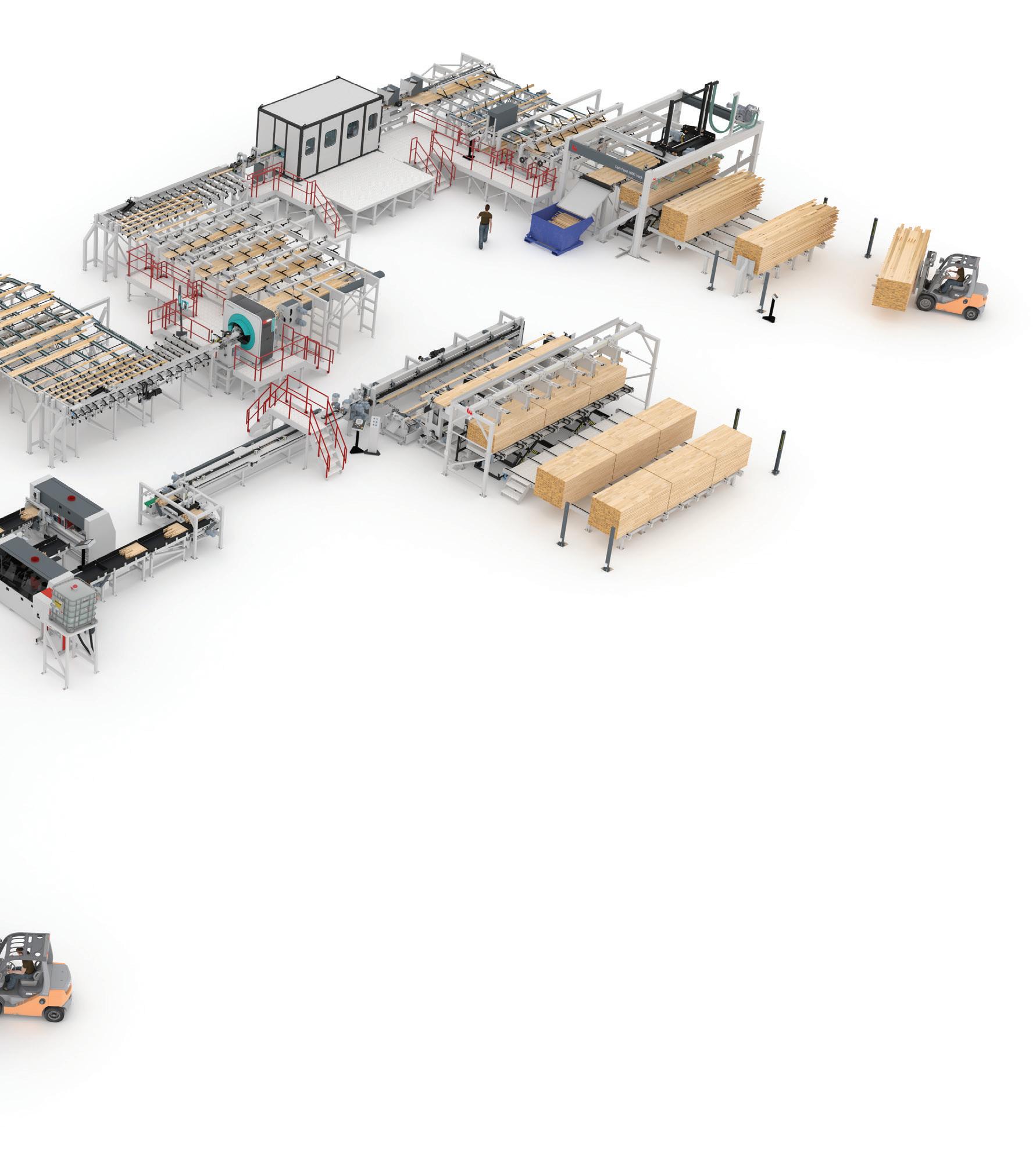


3
Overview: Production: Windows & doors Wood species: Softwood Number of operators: HEAD CROSS CUT-SAW
workpieces stored in the container can be reintroduced to the line even when the line has been switched over to another production type. This way, it is possible to maximize the utilization of the finger-jointer.
‘‘We’re very pleased with System TM’s service and support as we’ve been in contact with well-trained engineers who know our line very well and we’ve experienced fast delivery times of spare parts. Due to this experience, we will also choose System TM as our equipment supplier for our next investment project which will be a moulding line for finger-jointed products.’’
Sägewerk Poschenrieder Adds and Subtracts Floor Space
System TM has recently developed a compact and versatile production line for Poschenrieder, functions within one system to accommodate Poschenrieder’s floor space constraints. willingness to provide Poschenrieder with as many layout revisions and modifications

Sägewerk Poschenrieder

Poschenrieder’s sawmill was established in 1898 in Grünenbach, Germany. Today, the company takes up a space of 40.000 m² and processes 70,000 m³ of wood per year, and therefore offsets 5000 people’s carbon foot print with its products every year.
Poschenrieder strives to operate as climate friendly as possible. The company’s raw material comes exclusively from sustainable forestry. At Poschenrieder, the entire trunks are used to minimize waste. By-products are used for internal thermal energy production to dry Poschenrieder’s workpieces. By doing so, the company avoids having to use around 500,000 liters of heating oil every year.
Technical description
In Poschenrieder’s production line, packs are initially handled by a de-stacking machine, Opti-Feed 6000 Vack, which de-stacks the workpieces from the packs into the line, after which they pass through a moulder and into a scanner. The workpieces exit the scanner and enter an optimizing cross-cut saw, Opti-Kap 5103, which chops off unacceptable defects. Then, the workpieces are transported to a finger-jointer, Opti-Joint V-8 in which a batch builder creates batches of 600-millimeter width, after which the workpieces enter the two shapers of the line. After the shapers, the workpieces enter a press unit and come out pressed into lengths of up to 8 meters. Finally, the workpieces are strapped and packed into finished packs.
Poschenrieder’s production line also offers the possibility to produce moulded products without finger-jointing them. In other words, workpieces pass through the de-stacker, moulder and scanner, then bypass the crosscut saw and finger-jointer and go straight to the stacking machine where they are stacked into finished moulded packs.
As a result, Poschenrieder’s production line is a combined system with two production functions – cross-cutting combined with finger-jointing or moulding.
Cutting back on space but not functionality
Poschenrieder’s line offers the convenience of having two functions within one system. The line has also been designed this way to accommodate the space constraints in Poschenrieder’s production facility. There fore, System TM and Poschenrieder have collaborated closely to come up with the best
possible solution that fits into their available space. ''We’ve successfully designed a system which can carry out several process es while taking up almost no space. Having two production functions within one system allows Poschenrieder to run both types of products’’ , says Per Jensen, Area Sales Man ager of Central Europe, Australia, and New Zealand at System TM.
From standalone to consolidated machinery
Poschenrieder used to have a similar system yet on a smaller scale. Their operators used to manually add work pieces to their cross-cut line, after which the workpieces were manually moved to a standalone finger-jointer. Consequently, Poschenrieder was unable to carry out large volume productions. This necessitated the automation of Poschenrieder’s production processes to increase their production capacity. ‘ ‘Poschenrieder now has new, up dated machinery which they can enjoy for the next many years. Their production is much more consistent and consolidated compared to their previous production which
was done using standalone equipment’’, says Per Jensen.
Important factors leading up to the investment System TM was able to close the deal with Poschenrieder by exhibiting flexibility and perseverance. In practice, this includes the ability to keep clients informed and up dated throughout the entire project process and providing clients a single point of contact at System TM rather than involving several System TM employees in projects. ‘‘Having a single point of contact creates recognition and closer ties which are important elements in our way of doing business with clients’’ , says Per Jensen.
Poschenrieder’s line is not your ordinary line in the sense that it is highly compact and takes up little space without sacrificing functionality.
‘‘Wehadhighexpectationsforourline,aswe wanted a line with maximum flexibility and as compact as possible. System TM came up withthebestsolutionforouravailablespace. Visiting the company in Denmark and some of their other lines inEuropegaveusthecon fidence to proceed with the project together.
4
The System TM batch builder creates batches of 600-millimeter width.
>> Personal statement by Timo Poschenrieder, Production & Development at Poschenrieder:
OPTI-FEED 6000 VACK Automated feeding system OPTI-JOINT V-8 Vertical finger jointing machine
Adds Functionality
Poschenrieder, a Germany-based sawmill. The line offers the convenience of having two constraints. The design process of the line has been characterized by System TM’s strong as needed to meet the client’s requirements to the fullest.

The project planning and installation of the line washighlyorganizedandwasperformed withoutanyissues’’ , says Timo Poschenrieder, Production & Development at Poschenrieder.
Post-installation tasks and after-sales support
After completing the installation of the line, a few adjustments were made to ensure the line runs successfully and delivers what Poschenrieder has been promised. ‘‘Togetthe line to run the expected production volume, some extra service visits and mechanical adjustments were made, and now we are at
where we want to be. With the finger-jointer bypass function, we can run the line in an “only mould” mode. This flexibility helps us increase our overall equipment availability’’, says Timo Poschenrieder.
Since then, Poschenrieder has received after-sales support to maintain production performance. System TM’s after-sales support does not only deal with upkeeping Poschenrieder’s machine performance, but also offers Poschenrieder the convenience of having to address all their questions to only one supplier since System TM is a one-stop solution provider of complete systems. Therefore, Poschenrieder can
get everything from System TM they need to maintain their line, and System TM can answer any questions related to their line as opposed to suppliers who work together with subcontractors to design solutions. ‘‘By relying on subcontractors, these suppliers do not acquire skills in-house and have no choice but to forward clientquestionstotheir related subcontractor which often results in long response times. At System TM, we can offer a stronger end-product since there is only one supplier that puts the entire system together’’, says Per Jensen.
The production facility in
>> This System TM solution consists of the following:
• An automated feeding system, Opti-Feed 6000 Vack
• A moulder
• A scanner
• An optimizing cross-cut saw, Opti-Kap 5103
• A vertical finger-jointing system, Opti-Joint V-8
• Press unit

• An automated stacking system, Opti-Stack 6000
PRESS UNIT

OPTI-KAP 5103

Optimizing cross-cut saw
Overview: Production: Windows & doors Wood species: Softwood Number of operators:
Overview: Production: Sawmill Wood species: Softwood Number of operators:
5
Grünenbach, Germany.
6000 Automated stacking system SCANNER
MOULDER OPTI-STACK
‘‘Due to our continued growth, we decided once again to opt for state-of-theart technology in machinery, and the truth is that System TM with its fingerjointing machine has fulfilled all the agreed requirements. All our expectations have been met, and we are very happy to have this new line which gave us greater stability in the process, higher yields, and volumes.’’
>> This System TM solution consists of the following:
• An automatic workpiece alignment, Opti-Feed Spinfeeder
• A single piece feeder, Opti-Feed L-200
• A horizontal finger-jointing system, Opti-Joint H-200
• Press unit
• A multiple head cross-cut saw
Enrique R. Zeni y Cía S.A. Achieves Quick Return on Investment by Automating Manual Processes
Maximum output and minimum labor needs are two key reasons behind Zeni’s decision to invest in a System TM finger-jointing line. The line helps Zeni increase production capacity, reduce the need for manual labor, and maximize the usage of raw material. With these capabilities combined, it is possible for Zeni to achieve quick return on investment.


Enrique R. Zeni y Cía S.A.
Enrique R. Zeni y Cía S.A. is an Argentinian family-owned company that began its business as a grain broker in 1940. Since then, the company has expanded in this area and has also become involved in other business areas. Today, the company’s business units cover grain, cereals and oilseed origination, capital markets, forestry, wood industrialization, and cattle production.
Zeni’s presence in both the forestry and mill work industries allows the company to reap the benefits of having control over production processes related to the forestry and mill work industries. As a result of this production process control, Zeni can ensure high quality standards and best environmental practices, including green logistics and cost efficiency.
In the late 1970’s, Zeni established its forestry and millwork business units in Esquina in the province of Corrientes, Argentina. Today, the company has a factory with sawmills and mill work machines that covers an area of 41,000 m2 in total. Zeni’s factory is equipped with state-of-the-art machinery, including two saw mill production lines, a high-tech kiln, and re manufacturing machines.

A large part of the company’s production is exported to countries such as the United States, United Kingdom, Israel, and Italy. Zeni’s products include molding profiles, ceiling and wall paneling, components for doors, windows, and stairs, bed strips, edge glued panels, and wood pellets.
The Opti-Joint H-200 line
Zeni’s finger jointing line, the Opti-Joint H-200, starts with automatic in-feeding using a spin feeder. Workpieces of various lengths enter the spin feeder, after which an Opti-Joint
H-200 finger jointer finger-joints workpieces horizontally by gluing and pressing them together. Then, the workpieces are split into identical lengths (6 meters) and are now usable for panels. Up to three workpieces can be made at once and then stacked automatically. The finger jointer runs up to two hundred workpieces per minute. ‘‘To produce this many workpieces in such a brief amount of time, we need to automate the line so the workpieces can automatically be fed into the line, rather than having operators insert work pieces manually into the line. With automa tion, we only need 1-2 operators to run this finger-jointing line’’ , says Per Jørgensen, CSO of System TM.
The material flow in this System TM line comes from Zeni’s walking floors which are placed in close proximity to the finger jointing line. The walking floors are originally fed by Zeni's cross-cutting line which drops workpieces into large bins. Once the bins reach a workpiece content of twenty cubic meters, it is possible to unload the workpieces onto a belt, which then transports the workpieces to the fingerjointing machine. This is one way of feeding the finger-jointer.
Another way of feeding the finger-jointer can be done from Zeni’s small storage boxes which are originally supplied by Zeni's cross-cutting line. It is possible to unload workpieces from the boxes onto a belt, and then transport them to the finger-jointing machine.
Maximum output, minimum labor needs
The Opti-Joint H-200 finger jointer operates at high capacity and speed to produce consistent products of exceptional quality and strength. With Zeni’s new finger jointer, the company’s production capacity is now at least
one and a half times better than it was when the company used manual machinery.
In addition, the Opti-Joint H-200 finger jointer requires no more than 1-2 operators to run the machine. The reduction of operators from twelve in the past to 1-2 at present is a result of implementing workflow automation all the way through the finger jointer line. ‘‘Itiscommonfor companieswithmanualproductiontohave6-8 operatorsrunningonefingerjointingmachine, while producing on average 130 workpieces per minute. It isn’t possible to produce much more than 130 workpieces per minute if in feeding and stacking are done manually. Thanks to their new finger jointer, Zeni now has a maximum of 1-2 operators running 180200workpiecesperminute’’, says Per.
The Opti-Joint H-200 finger jointer also features a trim saver which ensures maximum usage of raw material, as it only trims off the necessary parts of the workpieces and thus, minimizes waste.
With an increased production capacity, reduced need for labor, and maximum usage of raw material due to the trim saver's function, Zeni is now well-equipped to achieve quick return on investment.
Important criteria in supplier selection process
In Zeni’s supplier selection process, the company placed emphasis on the ability to fit a production line into their available floor space, to construct a line with material flow coming directly and effortlessly from their walking floors and small boxes, and to implement workflow automation throughout the entire production process from a to z. ‘‘Zeni’s specific criteria were fully met by System TM, as we were able to design a solution that both fulfills Zeni’s production needs and fits perfectly into their production facility’’, says Per Jørgensen.
Listening to customers and acting on their input
At System TM, customer collaboration and teamwork are essential elements of designing a production line. ‘‘By listening to customers and acting on their input, we can achieve high customer satisfaction and provide our customers with a production line that’s more relevant to their needs. The Zeni project was noexception.Bycombiningourstrongproject management skills with valuable input from Zeni, we ended up with exactly what Zeni requested’’, says Per.
6
Overview: Production: Windows & doors Wood species: Softwood Number of operators:
Overview: Production: Moulding & Millwork Wood species: Softwood Number of operators:
>>
Zeni's production line in Esquina, Argentina.
Personal statement by Patricio Zeni, Zeni:
OPTI-JOINT H-200 Horizontal finger jointing machine MULTIPLE HEAD CROSS-CUT SAW OPTI-FEED SPINFEEDER Automatic workpiece alignment OPTI-FEED L-200 Single piece feeder PRESS STATION
Setra Group Maximizes Machine Utilization Through Flexible, Automated Solution
Setra, one of Sweden's largest wood products companies, can now produce two different product types using the same production line. Although Setra has fluctuating amounts of raw materials for one product type, the company can still get the most out of its new System TM-Kallesoe line by simply switching to another product type. By operating with maximum machine utilization, Setra can drastically shorten its payback period.

The Setra Group
Setra is a Swedish sawmill Group and one of Sweden's largest wood products companies with about 800 employees. The company processes raw materials from responsibly managed forests and offers environmentally friendly products and solutions for building and living in a global market. The Setra Group includes seven sawmills and three processing units.
Expanding production capacity
Setra has recently taken a strategic decision to invest heavily in boosting the refinement of its raw materials. Setra has been involved in the production of glulam beams for a long time. Today, the company also engages in CLT production and window component production. Thanks to their new System TM-Kallesoe line, Setra can now expand its production capacity of window components and glulam beams.
Finding the right type of solution
Setra was a new customer looking to invest in a production line for window components. While discussing a potential project with System TM, Setra expressed a desire to also produce glulam beams using their new production line. As a result, Setra was advised to invest in a multifunctional production line capable of producing both window components and glulam beams. The advantage of combining these two functions within one system is that the line will remain in operation at maximum capacity and usage, which will drastically shorten Setra’s payback period.
Intrigued by System TM and Kallesoe

After deciding to proceed with a multi functional production line, Setra was presented with a proposal for a highly integrated, multifunctional System TM-Kallesoe solution. ’’Setra was impressed with the level of integrationbetweenSystemTMand Kallesoe’s machinery. They were also enthusiastic about Kallesoe'spressandthewayitworks,especially how easy it is to change the stamping moulds needed for pressing their different types of profiles. By doing so, Setra can achieve high utilization of its press’’ , says Allan Them, Area Sales Manager for Scandinavia at System TM.
Customer collaboration is a priority
Customer collaboration is a priority through out the entirety of System TM’s customer relationships. System TM’s design process is all about being proactive, enterprising, and receptive to what customers have to say. The Setra project was no exception to the rule. ‘‘We made continuous adjustments to the layout to meet Setra’s specifications. Customers like to monitor the design process with a close eye to ensure everything happens as per they’ve planned. By collaborating with Setra, we were abletoexchangevaluableinformationandde sign the best solution for Setra’s needs. We hadagreatcollaborationwithSetra,bothwith thepeopleattheirfactoryandtheirconsultant whowasassignedthisproject’’ , says Allan.
Maximizing machine utilization
Thanks to their new System TM-Kallesoe line, Setra can now produce laminated window components at high capacity. Although Setra has fluctuating amounts of raw materials for their window component production (a common factor that causes low machine utilization), the company can still get the most out of its production line because it is possible to switch to glulam beam production when window component production is low. In this sense, a combined solution suits Setra’s needs very well. ‘‘This investment is worth every pennybecauseSetra’spaybackperiodisshort due to the efficiency of our automation with Kallesoeandtheflexibilityoftheproductsetup in this line. Setra is now able to make some of the world's best finger-jointed laminated window components and glulam beams. It's a great investment in sustainability and further processing’’, says Allan.
Technical description
One of Setra’s requirements for the System
TM-Kallesoe line was to connect it with the company’s existing finger jointer to enable the immediate transportation of workpieces from Setra’s finger jointer onto the System TM-Kallesoe line. Therefore, workpieces can move along a roller conveyor from Setra’s finger jointer to the System TM-Kallesoe line. Otherwise, workpieces are introduced to the System TM-Kallesoe line on another roller conveyor. Both roller conveyors lead to an automated infeed system, Opti-Feed 6000 Vack, which includes two pickup positions. To make glulam beams, Setra uses two different grades with the same dimension. To make window components, they use two different dimensions. Therefore, Setra needs two pick up positions to make it possible for the work pieces of either two different dimensions or two different grades to enter the line. When either two different dimensions or two different grades reach the Opti-Feed 6000 Vack, the feeding machine picks up either of the two different dimensions/grades and feeds them into the line piece by piece, after which they are cup measured and turned over. Then, the workpieces move down to the lower level, after which they enter two moulders. The line is equipped with two moulders to make the two different dimensions required for window components or the two different grades re quired for glulam beams.
After the moulders, the workpieces are proportioned into a Kallesoe high-frequency system where they are glued and pressed together, forming window components or glulam beams. As they exit the press, they en ter multiple cross-cut saw, Multikap MK2, which trims off their ends. Finally, the window com ponents/glulam beams are stacked in packs by an automated stacking machine, Opti-Stack 9000, and leave the line by means of a pack outfeed outlet.
‘‘The cooperation with System TM has been a very positive experience. System TM has handled every aspect of the process – from offer to delivery of the installed line – in a very professional manner. We particularly appreciate the fact that System TM has been able to deliver a complete line which fully comply with the needs specified. All the way, we have been dealing with highly competent System TM staff, enabling us to start up the line on schedule.”
This System TM solution consists of the following:
• An automated feeding system, Opti-Feed 6000 Vack
• Two moulders
• A Kallesoe glue application and lay-up system
• A Kallesoe high frequency press
Overview: Production: Windows & doors Wood species: Softwood Number of operators:
Overview: Production: Components Wood species: Softwood Number of operators:
• A multiple cross-cut saw, Multi-Kap MK2
• An automated stacking system, Opti-Stack 9000
• Material handling
7
KenthLundagårdsandFredrikEriksson, Setra, Sweden, in front of their new System TM line, (from left to right).
Personal statement by Kenth Lundagårds, Project Manager & Consultant at Setra:
>> >>
OPTI-FEED 6000 VACK Automated feeding system
MATERIAL HANDLING Automated equipment for efficient flow of material KALLESOE Glue application and lay-up system KALLESOE High frequency press OPTI-STACK 9000 Automated stacking system MULTI-KAP MK2 Mulitple head cross-cut saw
MOULDERS
IWF 2022








International Woodworking Fair, became the largest global woodworking trade show in North America since 2018. From August 23-26, System TM participated in the event along with our dealer for the North American market, Stiles Machinery, at Georgia World Congress Center in Atlanta. With a total registered attendance of 25,524, the show set an all-time record of first-time attendees with more than 48% new.




Trä & Teknik 2022

In August, 8,853 guests and exhibitors could finally meet at the Træ & Teknik fair (also known as the Wood & Technology fair) after a long time without the opportunity to meet face to face. The exhibition was a success with high activity, a positive energy, and many interesting meetings. System TM participated in the exhibition together with Kallesoe Machinery and our Swedish dealer L.O.A.B.
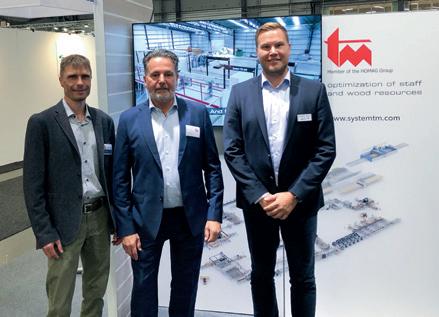
NHLA 2022
In September 2022, System TM participated in the 125th NHLA Annual Convention & Exhibit Showcase in Cleve land, Ohio. As always, it was a pleasure to present comprehensive end-to-end solutions together with our business partner Microtec and Stiles Machinery, our dealer for the North American market. The NHLA Annual Convention is the largest gathering of the hardwood lumber industry in North America, and we enjoyed meeting up with
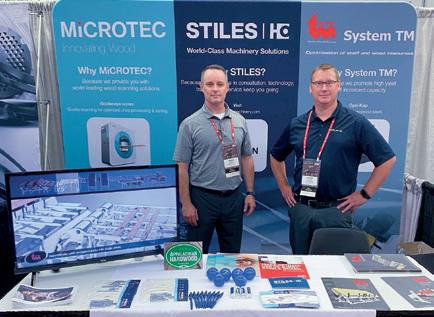
System TM A/S Skovdalsvej 35, DK-8300 Odder, Denmark, Tel:+45 86 54 33 55, tm@systemtm.com, www.systemtm.com no. 2 - 2022 www.systemtm.com Opti-Joint Automated finger-jointing systems Opti-Stack Automated stacking systems Opti-Feed Automated feeding systems Opti-Kap Optimizing cross-cut saws Opti-Solution Customized system solutions At System TM, we use our technical expertise, longstanding experience and integrated approach to design the best solution that meets your business objectives. Please visit our website at www.systemtm.com to find a material handling solution that fits your production requirements. System TM, a leading global provider of customized solutions for the solid wood industry System TM offers a wide range of automated material handling systems designed to provide high production capacity, maximum wood utilization and minimum labor costs. Our material handling systems are defined as standard system solutions and fully customized solutions designed to meet diverse customer needs. Visit System TM at the following exhibitions: NWFA, Wisconsin Center, Milwaukee, WI, USA ......................... May 2 - 4, 2023 LIGNA 2023, Hannover, Germany .............................................. May 15 - 19, 2023
of the HOMAG Group
Member
square feet of exhibit space, 900+ exhibitors presenting over 540 product categories, and with
more
tries,
With over 663,000
attendees from all over the US and
than 92 other coun
IWF 2022,
Be the first to know Join us on your favorite social media sites and get the very latest from System TM – product developments, customer success stories, and more! SOCIAL MEDIA Newsletter
our customers.
>> >> >>
Member of the HOMAG Group
Our booth at the Trä & Teknik fair. From the left to the right: Ulf Hildebrand, L.O.A.B., Allan Them, System TM, Kristian Kallesøe, Kallesoe Machinery.
Our booth at NHLA Convention & Exhibit Showcase. From the left to the right: David Ghisolfo and John Barnes. Both from Stiles Machinery.








































